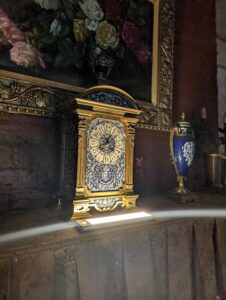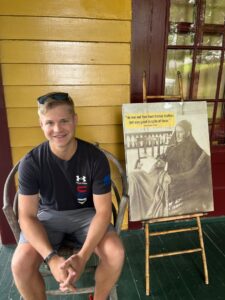139th Anniversary of Grant’s Death
I recently had the opportunity to visit the Ulysses S. Grant Cottage State Historic Site, a place that has been on my Civil War bucket list for a while now. But I was also eager that my trip coincided with the anniversary of Grant’s death on July 23.
Nestled in the Adirondack Mountains, Grant’s Cottage served as the former president’s home for only six weeks—the last six weeks of his life. The house is essentially a time capsule of 1885; many of the objects that accompanied Grant during his stay are still there and remain untouched. The clock that marked the time of his death at 8:06 AM has never been started again. A large bottle of cocaine water, used to treat Grant’s throat cancer, sits on a shelf half full and unused since his death. The large, Victorian funeral trappings that adorned the structure now reside in the cottage’s front parlor. Grant’s bed—the exact bed in which he died—also appears relatively untouched since that July day in 1885.

I think that was most moving for me, looking at the exact bed in the exact room on the exact day on which Grant died, 139 years later. But that’s the net positive of historic preservation. Historic sites provide windows or portals to the past and give us the opportunity to walk in the footsteps of the people that we, as lovers of history, strive to learn so much about.
I was also struck by the drama and tragedy of Grant’s last several months. By 1885, Grant had lost his fortune to a Ponzi scheme and was losing his life to cancer. As Grant turned to writing his memoirs to save his finances and reputation, he did so with the vigor with which he pursued the Confederate armies during the Civil War and prosecuted the Ku Klux Klan during Reconstruction. Grant succeeded in this race against time, finishing his memoirs just days before his death. The memoirs would prove to be his final battle and his final victory.

After touring the cottage, I hiked down to the overlook of the Hudson River Valley. Grant visited the this site for the last time on July 20, as caretakers wheeled his feeble 100-pound frame down the narrow path that overlooks one of America’s most historic landscapes. It seems fitting that Grant would spend his final days in a region so rich in military history. The Saratoga and Bennington battlefields, the Green Mountains of Vermont and the Catskills of New York, are all visible from the overlook. To the north, Grant could see Glens Falls, an important setting in James Fenimore Cooper’s French & Indian War novel Last of the Mohicans and the place that Col. Henry Knox’s Noble Train of Artillery forded the Hudson. I would imagine Grant probably felt at home in the Adirondacks, surrounded by such military heritage.

When Benjamin Harrison visited the cottage in 1891, he professed, “It has been said that a great life went out here; but great lives, like that of General Grant, do not go out. They go on.” While Grant’s reputation has flickered in the century and a half since his death, Grant’s Cottage certainly preserves the enduring legacy of his successful generalship and courageous presidency.

A beautifully written tribute to Grant, thank you.
Thank you!
Nice to have met you last weekend, Evan. I really admire the dignity with which Grant met his death, and his desire to provide for the family he loved. The special pleading in the Memoirs……well…..?
Great meeting you as well, John!
Grant’s Cottage is truly.a.faithful time capsule. I have been moved every time I visit. (It is less than an hour from my home.) One quibble;.I don’t think you can see the Catskills from the site. You can see the Green Mountains to the east and you are in the Adirondacks.
It was definitely a moving experience! If my memory serves me well, I believe the informational sign said the Catskills were visible from the overlook, but I agree that it *seems* they would be too far south.
Thanks for remembering this great American.
Thanks for reading ?
Should be ! Instead of ?
“I feel that we are on the eve of a new era, when there is to be great harmony between the Federal and Confederate. I cannot stay to be a living witness to the correctness of this prophecy; but I feel it within me that it is to be so. The universally kind feeling expressed for me at a time when it was supposed that each day would prove my last, seemed to me the beginning of the answer to ‘Let us have peace.’ “
I was happy to see the cottage has that last line, “Let us have peace.” draped across the entrance booth